The Hall of Fame New York Giants represent the very best of Big Blue’s storied history. Players, coaches, and executives whose excellence, leadership, and passion helped shape the franchise and the NFL itself.
The New York Giants are one of the NFL’s most storied and respected franchises, with a proud history spanning generations of excellence. Few teams can match the legacy of the Hall of Fame New York Giants, a group of players, coaches, and executives whose impact helped shape both the franchise and the league itself. From founding figures to modern icons, these legends represent the heart of Big Blue tradition. Let’s take a closer look at the Giants who earned their place among the immortals in the Pro Football Hall of Fame.
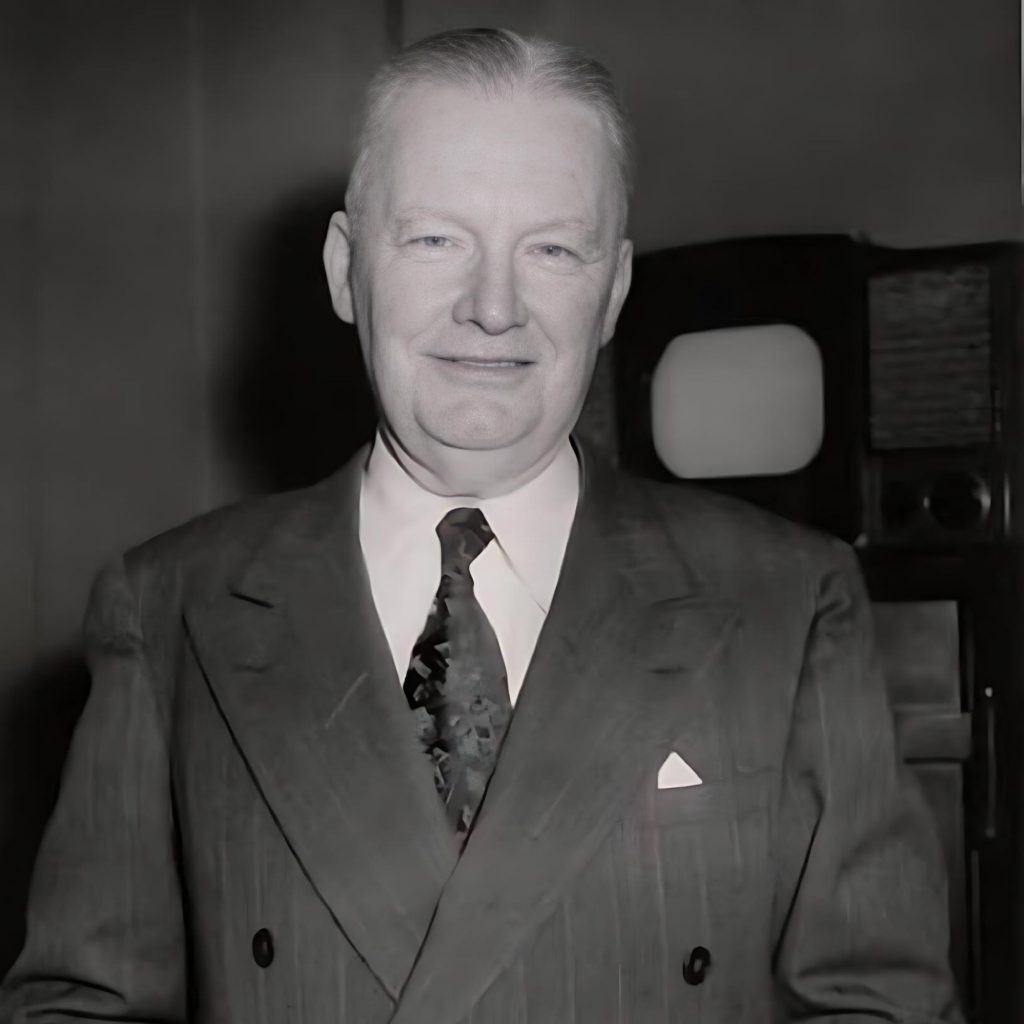
Tim Mara
Founder – 1925-1959
Hall of Fame Class of 1963
In 1925, NFL president Joe Carr was determined to establish a flagship team in New York City, and businessman Tim Mara answered the call, purchasing the franchise for just $500. Pro football faced stiff competition from the college game at the time, but a December matchup between the Giants and Red Grange’s Chicago Bears changed everything. The sold-out crowd at the Polo Grounds generated more than $140,000, proving that professional football could thrive in the nation’s biggest market.
Mara’s dedication carried the Giants through rival leagues and economic challenges, leading to the team’s first championship in 1927. Known for his integrity and generosity, he famously donated over $115,000 from a 1930 charity game to New York City’s unemployment fund. By the 1940s, Tim Mara’s steady leadership had transformed the Giants into one of the NFL’s cornerstone franchises — a legacy that still defines the team today.

Mel Hein
Center, Linebacker – 1931-1945
Hall of Fame Class of 1963
Mel Hein was the cornerstone of the New York Giants’ offensive line for 15 seasons and remains one of the most reliable players the league has ever seen. Playing in an era when athletes stayed on the field for every down, Hein rarely left a game — calling for a timeout only once in his entire career, and that was to reset a broken nose.
Renowned for his leadership and poise, Hein earned eight straight first-team All-NFL honors from 1933 through 1940 and captained the Giants for a decade. In 1938, his steady excellence earned him league MVP honors, a rare distinction for a center. Nicknamed “Cappy,” he was respected not only for his physical toughness but also for his football intelligence and sense of fair play.
A standout at Washington State before turning pro, Hein led the Cougars to the 1930 Rose Bowl. His decision to sign with New York — after nearly joining Providence — became one of the most important in franchise history, anchoring the Giants’ front line through more than a decade of championship-caliber football.

Steve Owen
Head Coach, Tackle – 1926-1953
Hall of Fame Class of 1966
Steve Owen’s legacy with the New York Giants spanned more than two decades of leadership, innovation, and quiet strength. A rugged lineman turned coach, he first joined the team as a player in 1926 and later served as player-coach before assuming full head coaching duties in 1931. Remarkably, he guided the franchise for 24 seasons, relying only on a handshake agreement with the Mara family — a reflection of the deep trust and respect he earned.
Owen built the Giants around discipline, fundamentals, and physical defense. His teams became perennial contenders, reaching eight NFL Championship Games and winning titles in 1934’s famed “Sneakers Game” and again in 1938. Always thinking ahead of his time, Owen introduced the “umbrella defense,” a groundbreaking scheme that reshaped how teams approached pass coverage and became a cornerstone of modern defensive football.
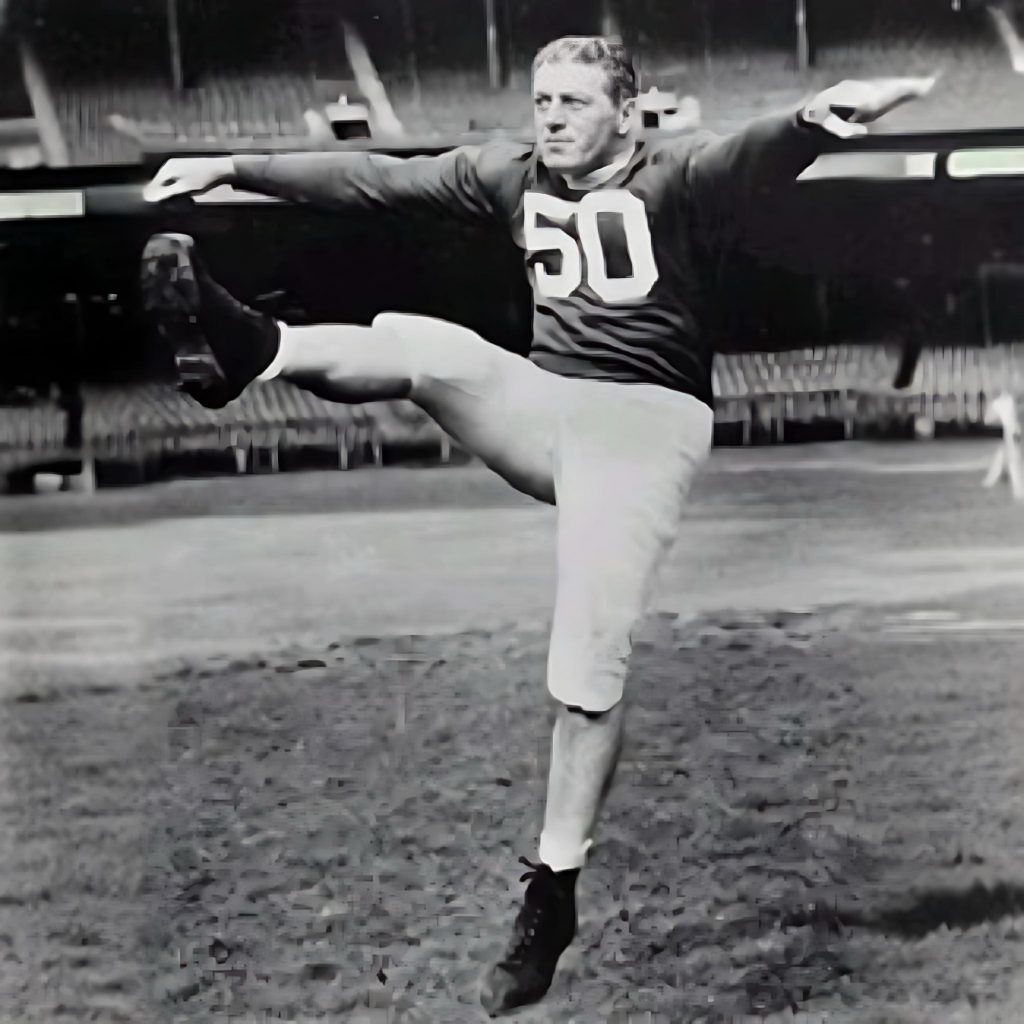
Ken Strong
Fullback, Halfback, Kicker, Punter – 1933-1935, 1939, 1944-1947
Hall of Fame Class of 1967
Ken Strong was one of the NFL’s earliest stars, celebrated for his rare versatility and game-changing performances. His most memorable moment came in the 1934 NFL Championship, known forever as the “Sneakers Game,” when he scored 17 of the Giants’ 30 points — two touchdowns, two extra points, and a field goal — powering New York to a stunning victory over the unbeaten Chicago Bears.
Strong’s all-around skill set made him invaluable. He could do it all — run with power, throw with precision, catch in traffic, kick under pressure, and tackle with authority. A standout at New York University, Strong first played professionally with the Staten Island Stapletons before signing with the Giants in 1933, where he quickly became one of the league’s most respected players.
Named All-NFL four times, Strong helped lead New York to multiple championship appearances and left an imprint on every facet of the game. Even after a brief retirement, he returned to the Giants during World War II as a kicking specialist — famously suiting up without shoulder pads and, legend has it, wearing his wristwatch onto the field..
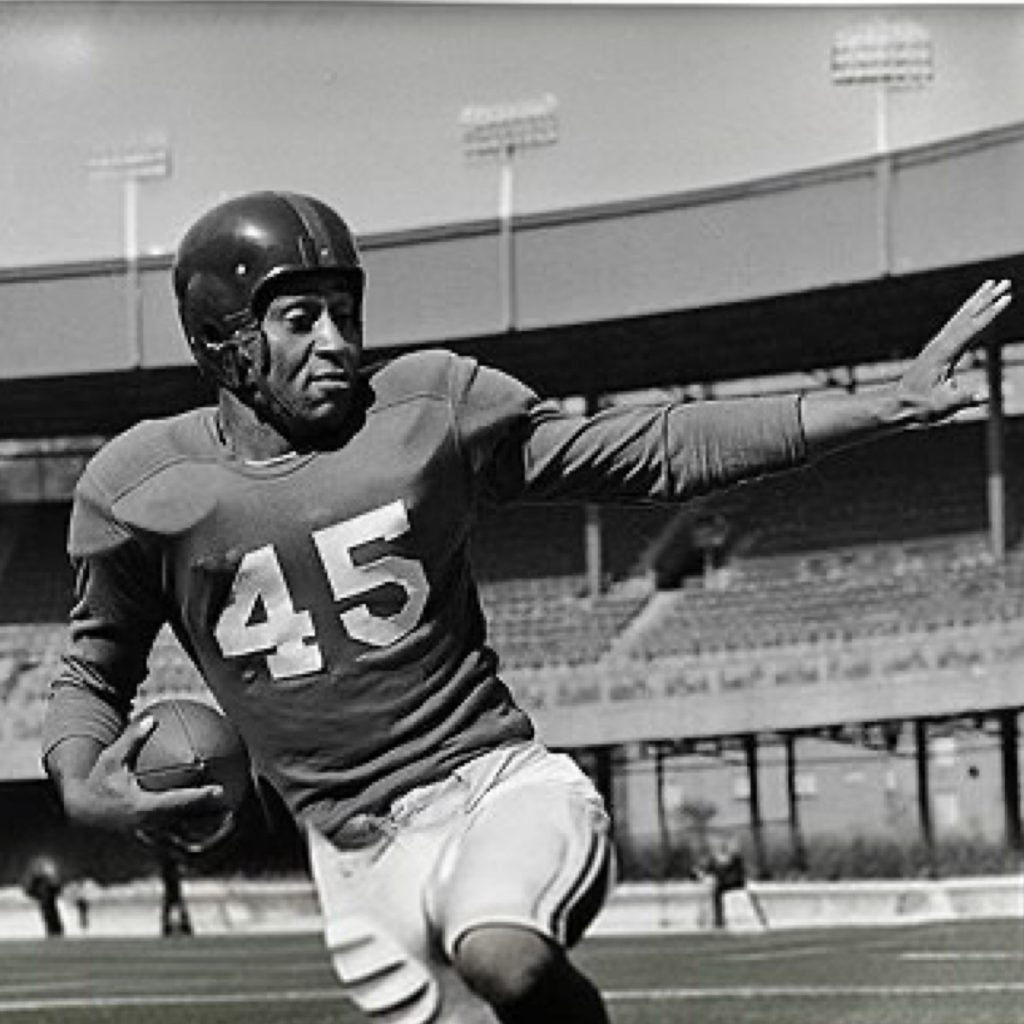
Emlen Tunnell
Safety, Returner – 1948-1958
Hall of Fame Class of 1967
Emlen Tunnell broke barriers and redefined what it meant to play safety in the National Football League. Joining the New York Giants in 1948 as an undrafted free agent, he became both the first African American to play for the franchise and later, the first to be inducted into the Pro Football Hall of Fame.
Tunnell’s instincts and range made him the cornerstone of the Giants’ famed “umbrella defense,” a system that confused opponents and anchored one of football’s toughest defensive units during the 1950s. Known as the team’s “offense on defense,” he possessed an uncanny ability to read plays before they developed and turn takeaways into scoring chances. Over his 14-year career with the Giants and the Green Bay Packers, Tunnell intercepted 79 passes — a record that stood for years.
His path to football greatness was anything but ordinary. After suffering a severe neck injury in college and being turned away by the Army and Navy during World War II, he served courageously in the Coast Guard before returning to play at the University of Iowa. When no team drafted him, Tunnell simply walked into the Giants’ offices seeking a tryout — a decision that would change the franchise’s history forever.
Smart, humble, and fearless, Emlen Tunnell was not only a defensive innovator but also a pioneer who helped pave the way for generations of players to follow.

Andy Robustelli
Defensive End – 1956-1964
Hall of Fame Class of 1971
Andy Robustelli was the definition of toughness and leadership, a relentless competitor who became one of the greatest defensive ends in NFL history. Drafted in the 19th round by the Los Angeles Rams in 1951 out of tiny Arnold College, Robustelli was a longshot to make the team — but his determination quickly erased any doubts. He helped the Rams win a championship as a rookie before being traded to the New York Giants in 1956, where he reached new heights.
In New York, Robustelli’s impact was immediate. A leader both on and off the field, he helped mold the Giants into one of the league’s most respected teams and guided them to an NFL title in his first season. Though undersized for his position at 230 pounds, he became one of the most feared pass rushers in football through technique, grit, and intelligence.
A seven-time All-Pro and seven-time Pro Bowl selection, Robustelli’s excellence was recognized in 1962 when he was named the NFL’s Outstanding Player by the Maxwell Club — a rare honor for a defensive player. Known as much for his professionalism as his play, Andy Robustelli set the standard for what it meant to be a Giant.

Y.A. Tittle
Quarterback – 1961-1964
Hall of Fame Class of 1971
Y.A. Tittle joined the New York Giants late in his career, but his time in New York cemented his place among football’s greats. After standout years with the Baltimore Colts and San Francisco 49ers, Tittle arrived in 1961, bringing experience, leadership, and a fiery competitiveness that immediately lifted the franchise.
Initially viewed as a stopgap veteran, Tittle quickly silenced any doubts by leading the Giants to three straight division titles from 1961 through 1963. He revitalized the team’s offense with his precision passing and fearless command of the huddle. In 1962, he set an NFL record with 33 touchdown passes, then broke it the following year with 36 — earning back-to-back NFL Player of the Year honors.
Known for his toughness and passion, Tittle was the face of the Giants’ “glory years” of the early 1960s. When he retired, he held nearly every major passing record, including completions, yards, and touchdowns. His name became synonymous with perseverance, excellence, and the spirit of New York Giants football.
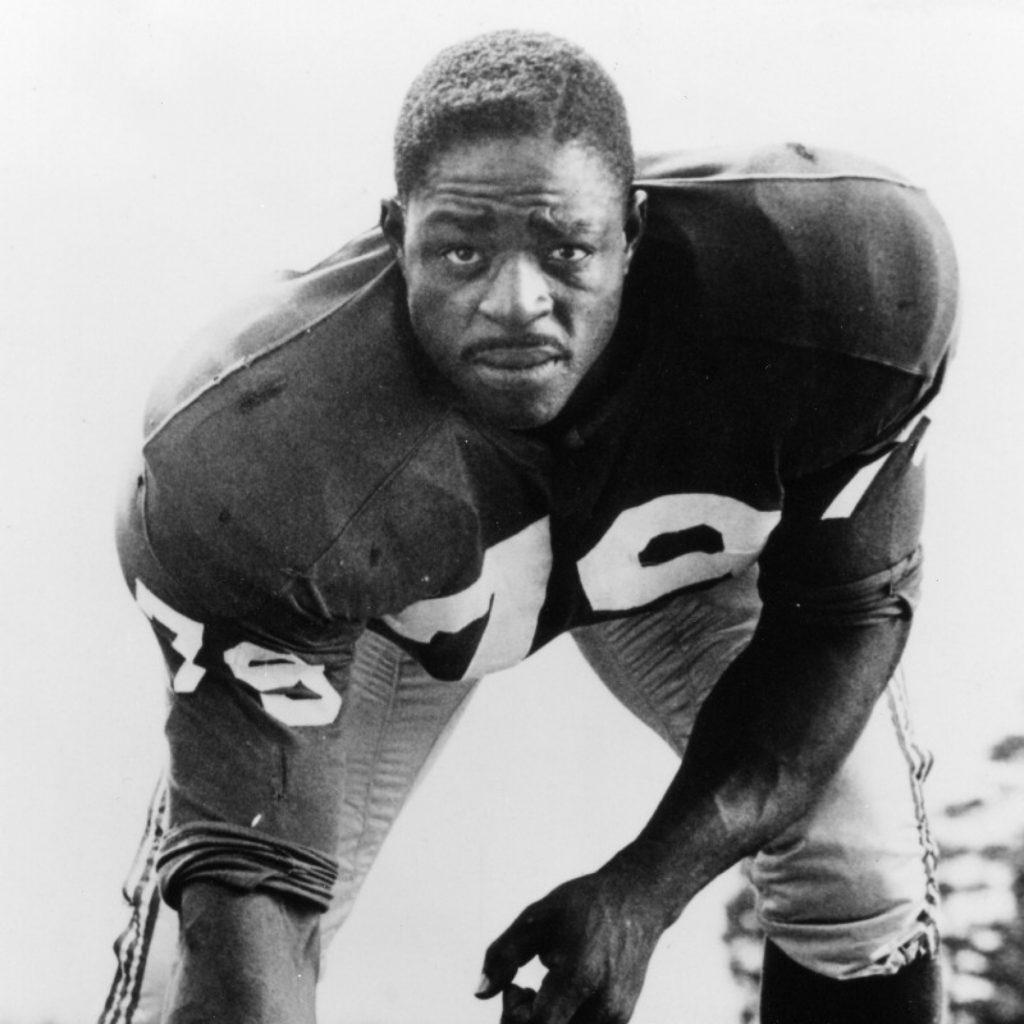
Roosevelt Brown
Offensive Tackle – 1953-1965
Hall of Fame Class of 1975
Roosevelt “Rosey” Brown was one of the greatest offensive linemen of his era, a quiet force who anchored the New York Giants’ front line for more than a decade. Drafted in the 27th round of the 1953 NFL Draft out of Morgan State, Brown was an overlooked prospect who quickly proved he belonged among the game’s elite.
With remarkable speed, strength, and balance, Brown became a dominant left tackle known for both his graceful pass protection and his punishing run blocking. His ability to pull and lead on outside runs made him a rare athletic marvel for his time. During his 13-year career, the Giants won six divisional titles and one NFL championship, with Brown consistently serving as the engine of the offense.
A nine-time Pro Bowl selection and eight-time All-NFL honoree, Brown earned Lineman of the Game honors in the 1956 NFL Championship and later became only the second player ever inducted into the Pro Football Hall of Fame solely for offensive line play. His blend of power, technique, and humility made him a true cornerstone of Giants history.

Ray Flaherty
Offensive/Defensive End – 1929, 1931-1935
Hall of Fame Class of 1976
Ray Flaherty’s impact on football extended far beyond his years as a standout end for the New York Giants. Known for his sharp football mind and quiet intensity, Flaherty helped establish the Giants as early NFL contenders before transitioning into one of the most innovative coaches of his generation.
After his playing days, Flaherty took over as head coach of the Boston Redskins in 1936, boldly predicting a championship before the season began. He didn’t deliver that year, but within a few seasons — and after the team’s move to Washington — he guided the Redskins to two NFL titles and four division crowns.
Flaherty was an early pioneer of modern offensive strategy, introducing the behind-the-line screen pass and experimenting with early versions of the two-platoon system. His creativity helped shape how the game is played today. A proven winner and a true football visionary, Ray Flaherty’s legacy remains woven into the history of both the Giants and the NFL.
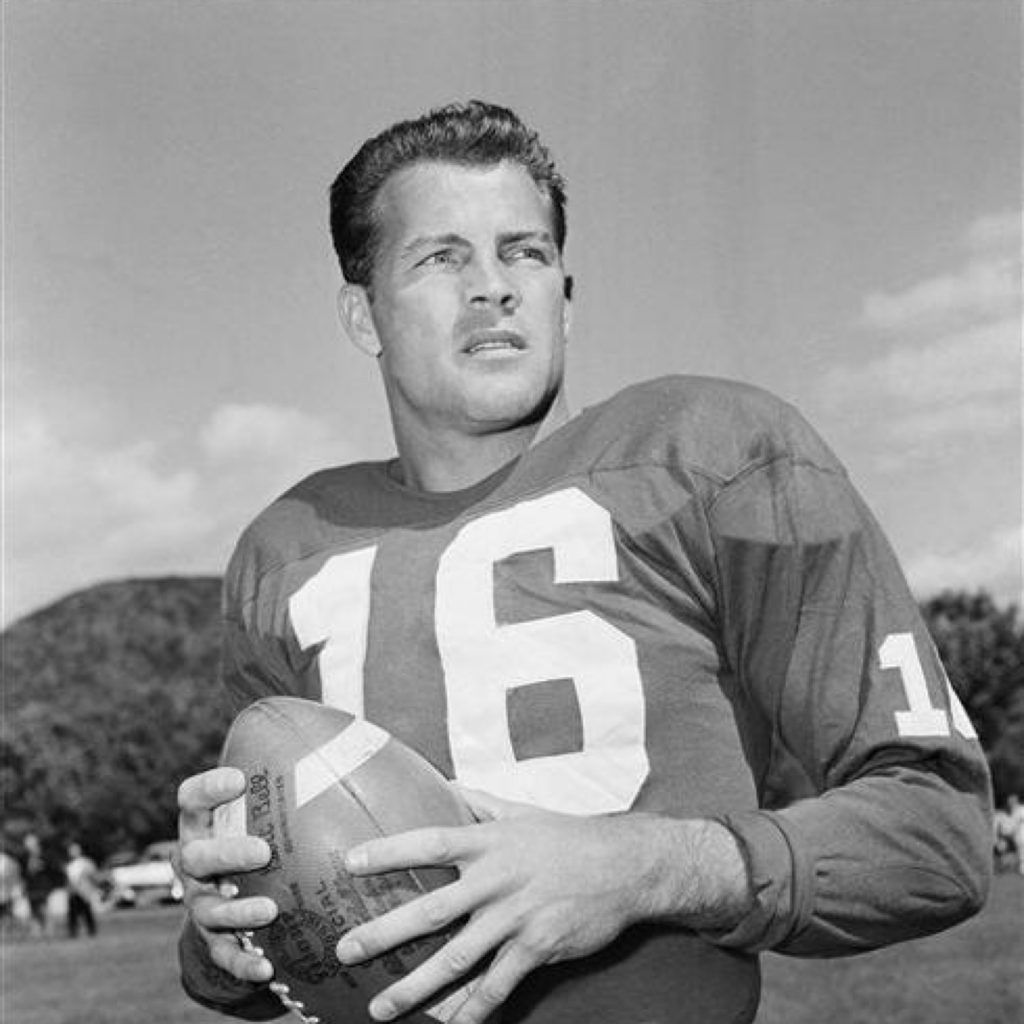
Frank Gifford
Halfback, Flanker, Cornerback – 1952-1960, 1962-1964
Hall of Fame Class of 1977
Frank Gifford was the face of the New York Giants through one of the franchise’s golden eras, a versatile star whose skill and determination defined 1950s football. Drafted in 1952 out of USC, Gifford quickly became the centerpiece of the Giants’ offense — a player who could run, pass, catch, defend, and return kicks with equal brilliance.
In 1956, he earned NFL Most Valuable Player honors while leading the Giants to a championship. His ability to impact every facet of the game made him one of the league’s most complete players. A devastating head injury in 1960 briefly ended his career, but Gifford’s resilience shined when he returned two years later as a flanker, seamlessly reinventing himself and reclaiming All-Pro form.
Over 12 seasons, Gifford earned eight Pro Bowl selections at three positions — defensive back, halfback, and flanker — a testament to his unmatched versatility. Charismatic and clutch, he symbolized the Giants’ excellence on the field and became one of the NFL’s most enduring icons.
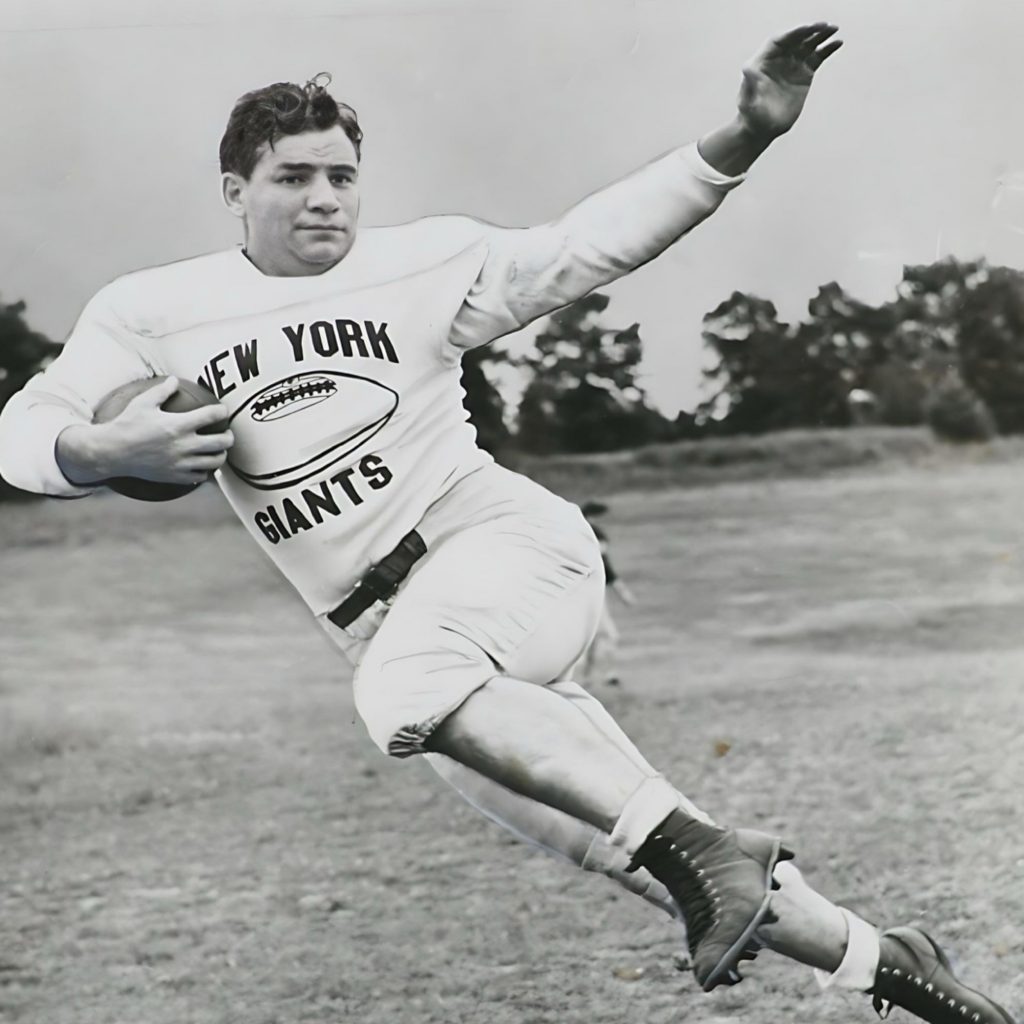
Tuffy Leemans
Halfback, Fullback – 1936-1943
Hall of Fame Class of 1978
Alphonse “Tuffy” Leemans was one of the New York Giants’ first true stars, a rugged and dependable back who carried the offense through the late 1930s. His discovery came by chance — a young Wellington Mara spotted him starring for George Washington University and convinced his father, team owner Tim Mara, to draft him second overall in the NFL’s first college draft in 1936.
Leemans made an immediate impact, leading the league in rushing as a rookie and earning first-team All-NFL honors. Tough, versatile, and fiercely competitive, he played both fullback and halfback while excelling on defense. From 1936 through 1942, he was named first- or second-team All-League every season, anchoring the Giants during one of their most successful early stretches.
By the end of his eight-year career, Leemans had rushed for more than 3,100 yards, thrown for over 2,300 more, and scored 45 total touchdowns. A true all-around talent, he embodied the toughness and determination that became synonymous with Giants football.

Red Badgro
Offensive/Defensive End – 1930-1935
Hall of Fame Class of 1981
Morris “Red” Badgro was one of the NFL’s earliest two-way stars, a sure-handed end and dependable defender who helped lay the foundation for the New York Giants’ early success. His journey to football greatness was anything but typical — after one season with the New York Yankees in 1927, he left the sport to pursue a career in Major League Baseball with the St. Louis Browns before returning to the Giants in 1930.
Over six standout seasons in New York, Badgro became one of the league’s most consistent and respected players. He earned All-League honors four times and made history in 1933 by scoring the first touchdown in an NFL Championship Game. Known for his steady tackling, crisp route running, and fearless play, he was a key contributor in the Giants’ rise as one of football’s dominant teams.
In 1981, nearly half a century after his final NFL game, Badgro was inducted into the Pro Football Hall of Fame at the age of 78 — then the oldest person ever honored. His career, spanning football’s early years, remains a testament to grit, longevity, and quiet excellence.
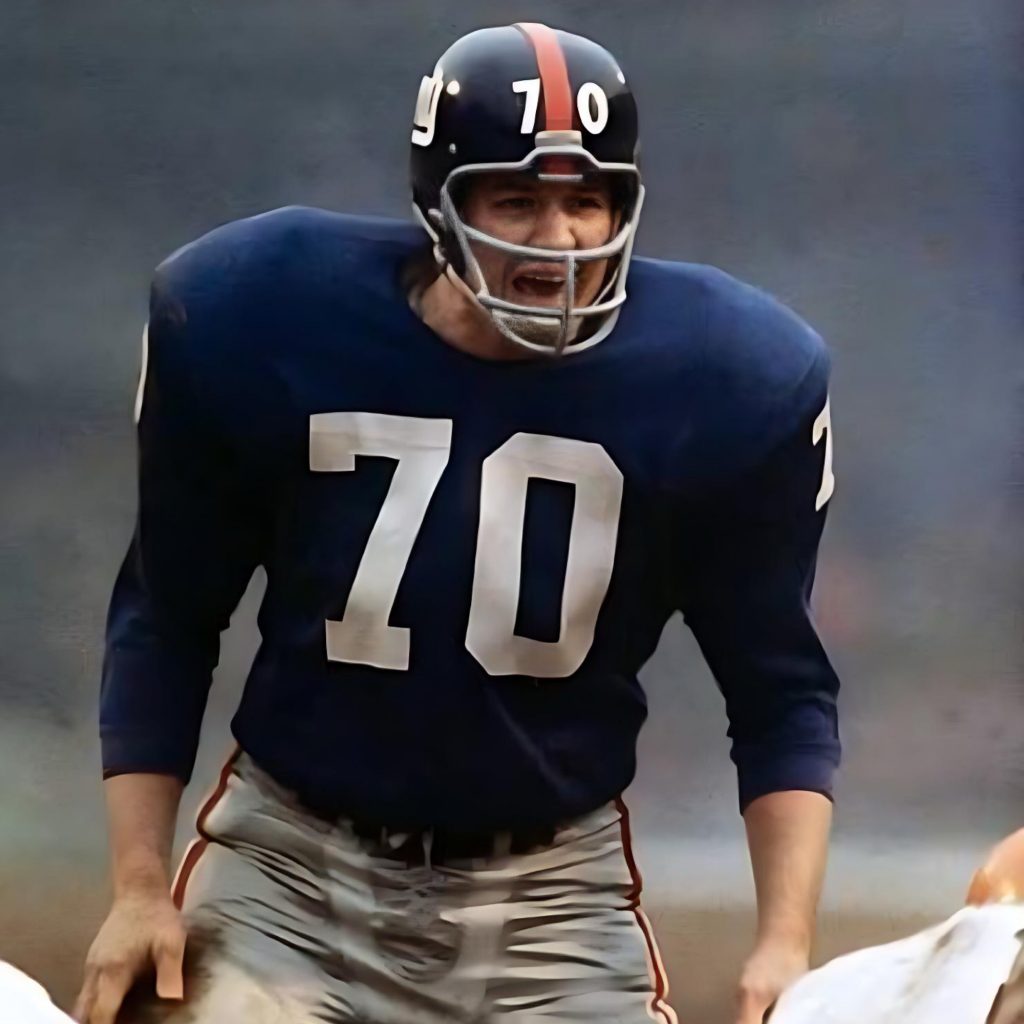
Sam Huff
Linebacker – 1956-1963
Hall of Fame Class of 1982
Sam Huff embodied the toughness and intelligence that came to define New York Giants football in the 1950s. As the anchor of the team’s defense, he became one of the NFL’s first true defensive superstars — even appearing on the cover of Time magazine and starring in the television special The Violent World of Sam Huff. His fierce play and magnetic presence helped turn defense into a spectacle for fans across the country.
A third-round pick in 1956 out of West Virginia, Huff nearly left Giants training camp before assistant coach Vince Lombardi convinced him to stay. Fate intervened when an injury opened a starting role at middle linebacker — a position Huff would redefine. He earned five Pro Bowl selections, three All-NFL honors, and was named the league’s top linebacker in 1959.
Known for his battles with legends like Jim Brown and Jim Taylor, Huff’s strength, instinct, and leadership made him the heart of the Giants’ feared defenses under coach Tom Landry. His passion and precision elevated the game and set the standard for generations of linebackers who followed.

Arnie Weinmeister
Defensive Tackle – 1950-1953
Hall of Fame Class of 1984
Arnie Weinmeister was a force of nature on the defensive line, a player whose dominance and athleticism left a lasting mark despite his brief professional career. Standing 6-foot-4 and weighing 235 pounds, he combined rare size, speed, and instincts to become one of the most feared tackles of his era.
Weinmeister began his pro journey with the New York Yankees of the All-America Football Conference in 1948 before joining the New York Giants in 1950. Over the next four seasons, he became the cornerstone of the Giants’ defense, earning unanimous All-NFL honors each year and four consecutive Pro Bowl selections. His ability to read plays, chase down quarterbacks, and command double teams made him a standout at a time when defense rarely drew headlines.
A natural leader, Weinmeister served as co-captain in his final season with the Giants and helped redefine what a defensive lineman could be. Though his career lasted only six years, his impact was immense — a legacy of power, intelligence, and innovation that earned him a rightful place in the Pro Football Hall of Fame.

Fran Tarkenton
Quarterback – 1967-1971
Hall of Fame Class of 1986
Fran Tarkenton brought creativity and fire to the quarterback position, rewriting how the game could be played. After beginning his career with the Minnesota Vikings, he joined the New York Giants in 1967, where his mobility and improvisational style electrified fans and transformed the team’s offense.
Known for his ability to escape pressure and extend plays, Tarkenton was far more than just a scrambler — he was a precise passer and masterful leader. In five seasons with the Giants, he posted some of the best numbers of his career and helped modernize the quarterback role with his blend of athleticism and intelligence.
After returning to Minnesota in 1972, Tarkenton led the Vikings to six division titles and three Super Bowl appearances. By the time he retired, he held nearly every major passing record, including completions, yards, and touchdowns. A nine-time Pro Bowler and one of football’s ultimate competitors, Fran Tarkenton’s innovation and flair forever changed the quarterback position.
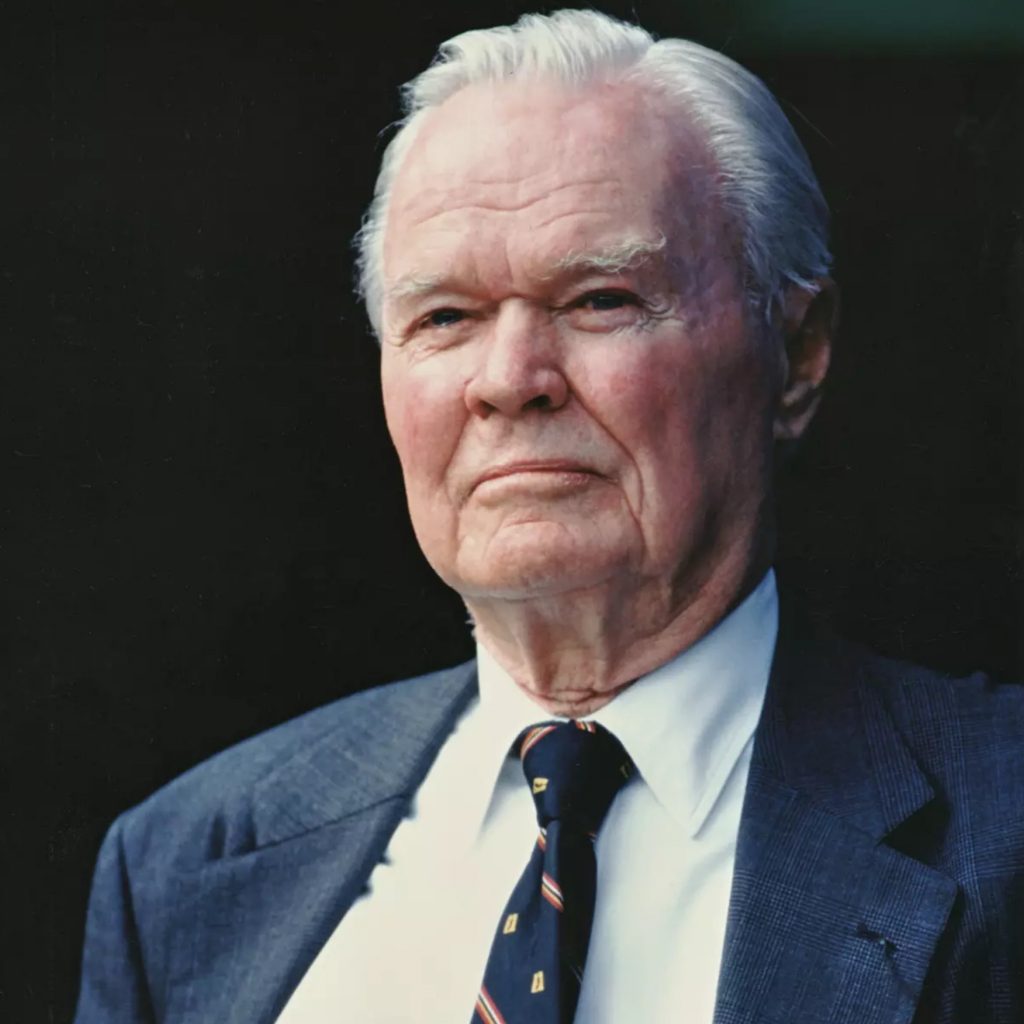
Wellington Mara
Co-Owner – 1937-2005
Hall of Fame Class of 1997
Wellington Mara dedicated his entire life to the New York Giants and to the game of football itself. The son of team founder Tim Mara, Wellington began working for the Giants while still a student at Fordham University, eventually rising through the ranks to become team president in 1965. His leadership and vision guided the franchise for nearly seven decades.
A master evaluator of talent and a steady hand in the front office, Mara helped shape multiple generations of Giants success. He drafted or acquired future Hall of Famers such as Frank Gifford, Roosevelt Brown, Lawrence Taylor, and Y.A. Tittle, and played a central role in the hiring of Bill Parcells. Under his direction, the Giants captured 16 divisional titles and four championships, including Super Bowls XXI and XXV.
Beyond New York, Mara was deeply respected across the NFL for his integrity and commitment to fairness. He served as president of the National Football Conference and sat on numerous league committees that helped shape modern football. Known simply as “The Duke,” Wellington Mara’s legacy is that of a builder, a leader, and the heartbeat of the Giants organization.

Lawrence Taylor
Linebacker- 1981-1993
Hall of Fame Class of 1999
Taylor revolutionized defensive football and redefined what it meant to dominate a game. Drafted second overall by the New York Giants in 1981 after a standout career at North Carolina, Taylor made an immediate impact, winning NFL Defensive Rookie of the Year and transforming the outside linebacker position from a supporting role into a game-breaking weapon.
With explosive speed, raw power, and unmatched instincts, Taylor became the cornerstone of the Giants’ defense throughout the 1980s. He was named first-team All-Pro in each of his first nine seasons, earned ten Pro Bowl selections, and helped lead New York to two Super Bowl championships.
Taylor’s 1986 campaign stands as one of the most remarkable in NFL history — 20.5 sacks, 105 tackles, and the league’s Most Valuable Player award, the first by a defensive player in over a decade. Fierce, fearless, and relentless, “LT” finished his career with 132.5 official sacks and a legacy that forever changed the way football is played.
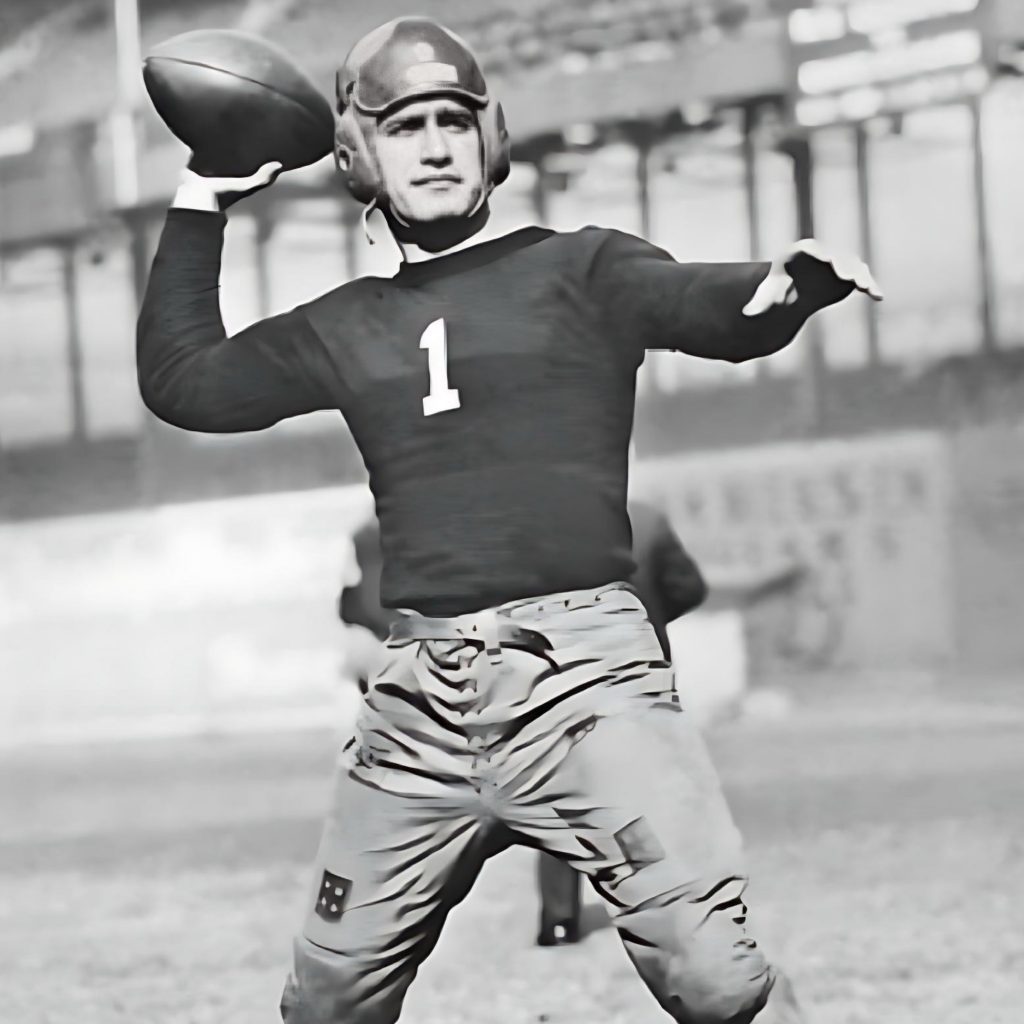
Benny Friedman
Quarterback – 1929-1931
Hall of Fame Class of 2005
Benny Friedman was the NFL’s first great passer, a trailblazer who helped turn football from a ground-and-pound game into an aerial spectacle. A two-time All-America quarterback at the University of Michigan, Friedman joined the professional ranks in 1927 and quickly became one of the sport’s biggest attractions.
After starring with the Cleveland Bulldogs and Detroit Wolverines, Friedman’s brilliance caught the attention of Giants owner Tim Mara, who purchased the entire Detroit franchise just to secure his services. With New York, Friedman became the face of the passing revolution, leading the league in touchdown passes four straight seasons and setting records that stood for years.
A true all-around player, he could run, kick, and lead with confidence, but it was his precision passing that transformed the game. Benny Friedman’s innovation and flair made him one of the NFL’s earliest superstars and a cornerstone of the league’s growth during its formative years.

Harry Carson
Linebacker – 1976-1988
Hall of Fame Class of 2006
Harry Carson was the emotional core of the New York Giants defense, a leader whose toughness and intensity defined Big Blue football in the 1980s. Drafted in the fourth round out of South Carolina State in 1976, Carson transitioned from college defensive end to NFL middle linebacker and quickly established himself as one of the best in the game.
Known for his fearless, physical play, Carson led the Giants in tackles five times and earned nine Pro Bowl selections, including seven straight from 1982 to 1988. His all-out style anchored a linebacker unit that featured Lawrence Taylor and Carl Banks, forming one of the most dominant trios in NFL history.
A consistent force in big moments, Carson’s leadership shined brightest during the Giants’ 1986 championship season, when he helped deliver the team’s first Super Bowl title. A six-time All-Pro and the heart of New York’s defense for more than a decade, Harry Carson embodied the grit, pride, and excellence of the Giants tradition.
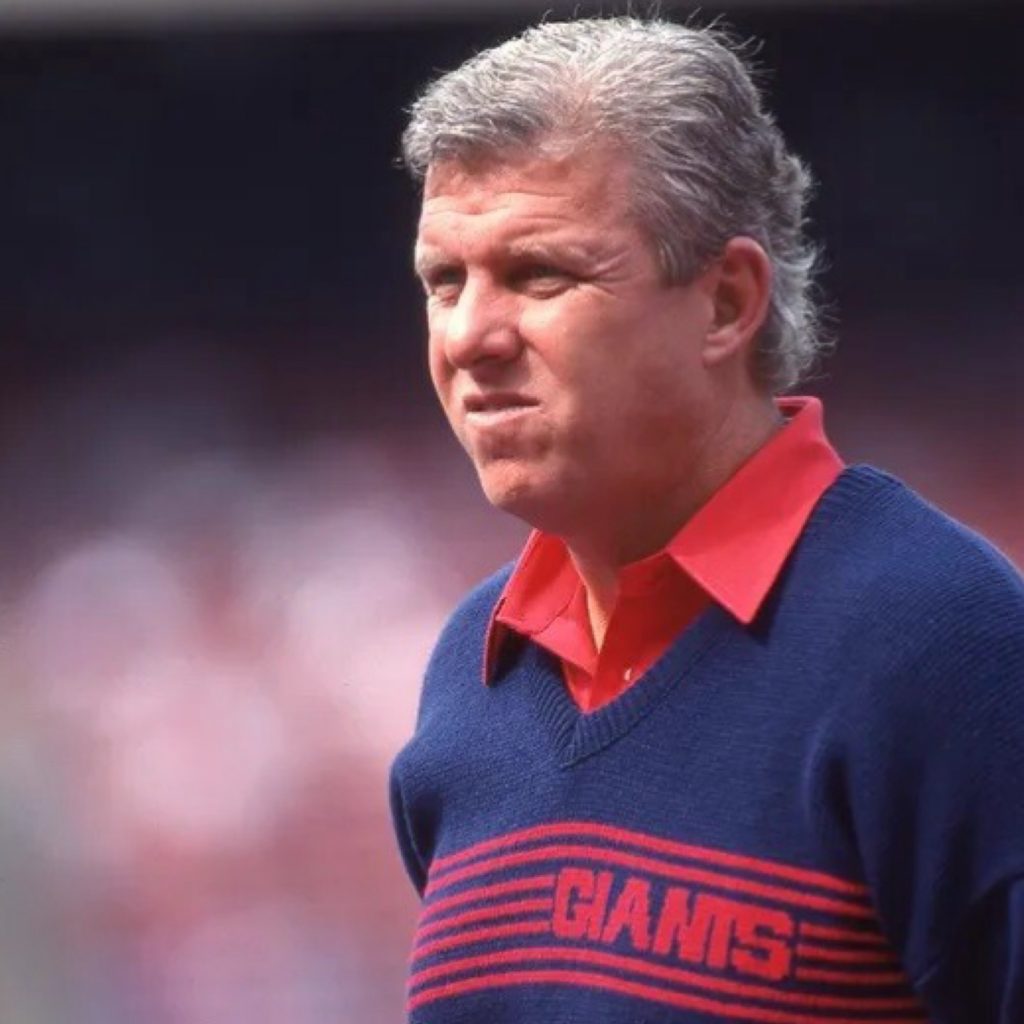
Bill Parcells
Head Coach – 1981-1990
Hall of Fame Class of 2013
Bill Parcells was the architect of the New York Giants’ modern championship era, a commanding presence whose leadership reshaped the franchise. When he took over as head coach in 1983, the Giants had endured a decade of frustration. Within three seasons, Parcells had them back in the playoffs — and by 1986, he delivered the team’s first Super Bowl victory with a dominant 14-2 campaign capped by a win over the Denver Broncos in Super Bowl XXI.
A master motivator and strategist, Parcells built his teams on discipline, toughness, and defense. Under his direction, the Giants earned another Lombardi Trophy in 1990, edging the Buffalo Bills 20-19 in one of the most dramatic games in NFL history.
Over 19 seasons as a head coach, Parcells turned around struggling franchises across the league, from the Giants to the Patriots, Jets, and Cowboys. Twice named NFL Coach of the Year, he left behind a legacy of championships, accountability, and the belief that preparation — not luck — builds winners.
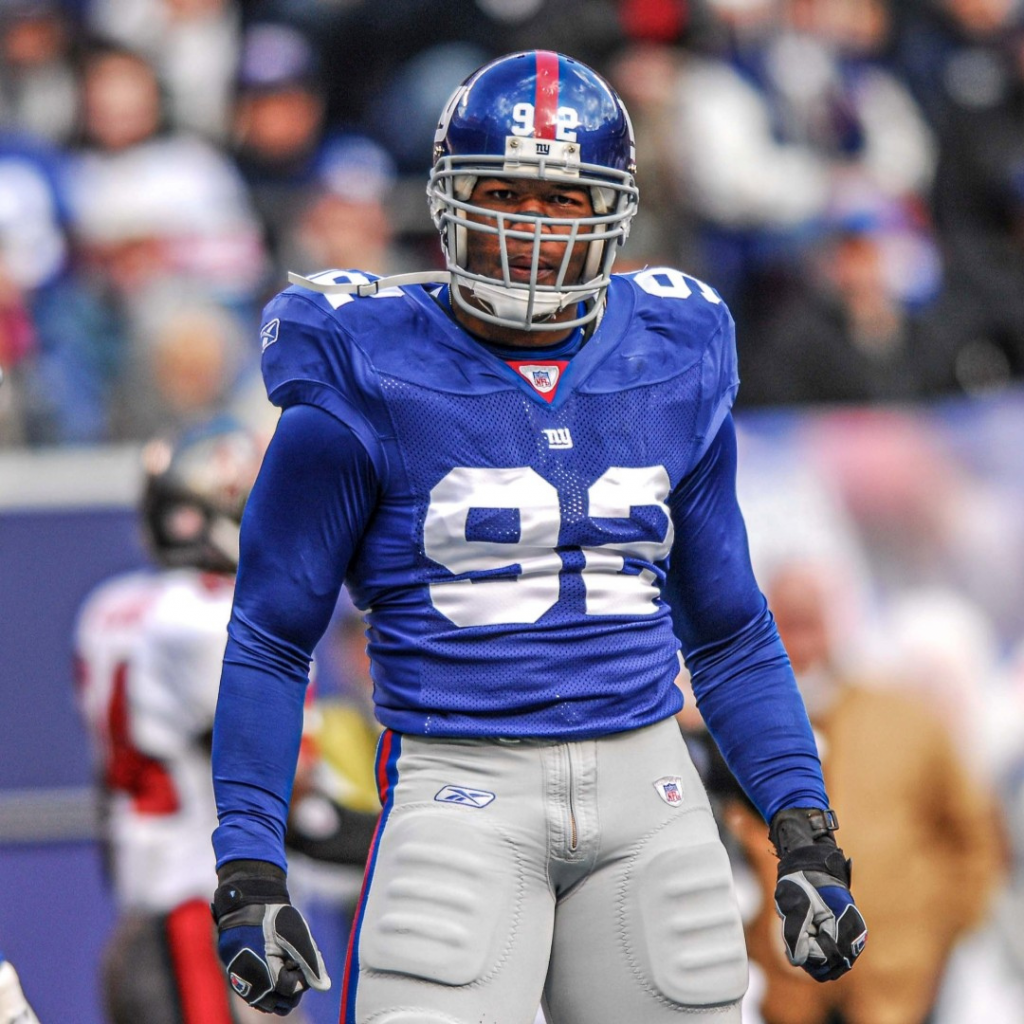
Michael Strahan
Defensive End – 1993-2007
Hall of Fame Class of 2014
Michael Strahan was the driving force of the New York Giants defense for 15 seasons, a relentless pass rusher whose power, leadership, and charisma made him one of the greatest defensive ends in NFL history. Drafted in the second round of the 1993 NFL Draft out of Texas Southern, Strahan brought with him a reputation for getting to the quarterback — and he more than lived up to it.
After overcoming an injury-shortened rookie year, Strahan became a fixture on the Giants’ defensive line. By 1997, he broke out with 14 sacks and earned his first All-Pro and Pro Bowl honors. Over his career, he would collect seven Pro Bowl selections, five first-team All-Pro nods, and the 2001 NFL Defensive Player of the Year award after setting the single-season sack record with 22.5.
A complete defender who excelled against both the pass and the run, Strahan’s leadership helped guide the Giants to two NFC Championships and a Super Bowl title. His final game — the team’s stunning 17-14 win over the undefeated New England Patriots in Super Bowl XLII — provided a perfect ending to a legendary career.
The Giants’ all-time sack leader with 141.5 and a member of the NFL’s All-Decade Team of the 2000s, Michael Strahan’s legacy stands as a lasting symbol of excellence, determination, and Giants pride.
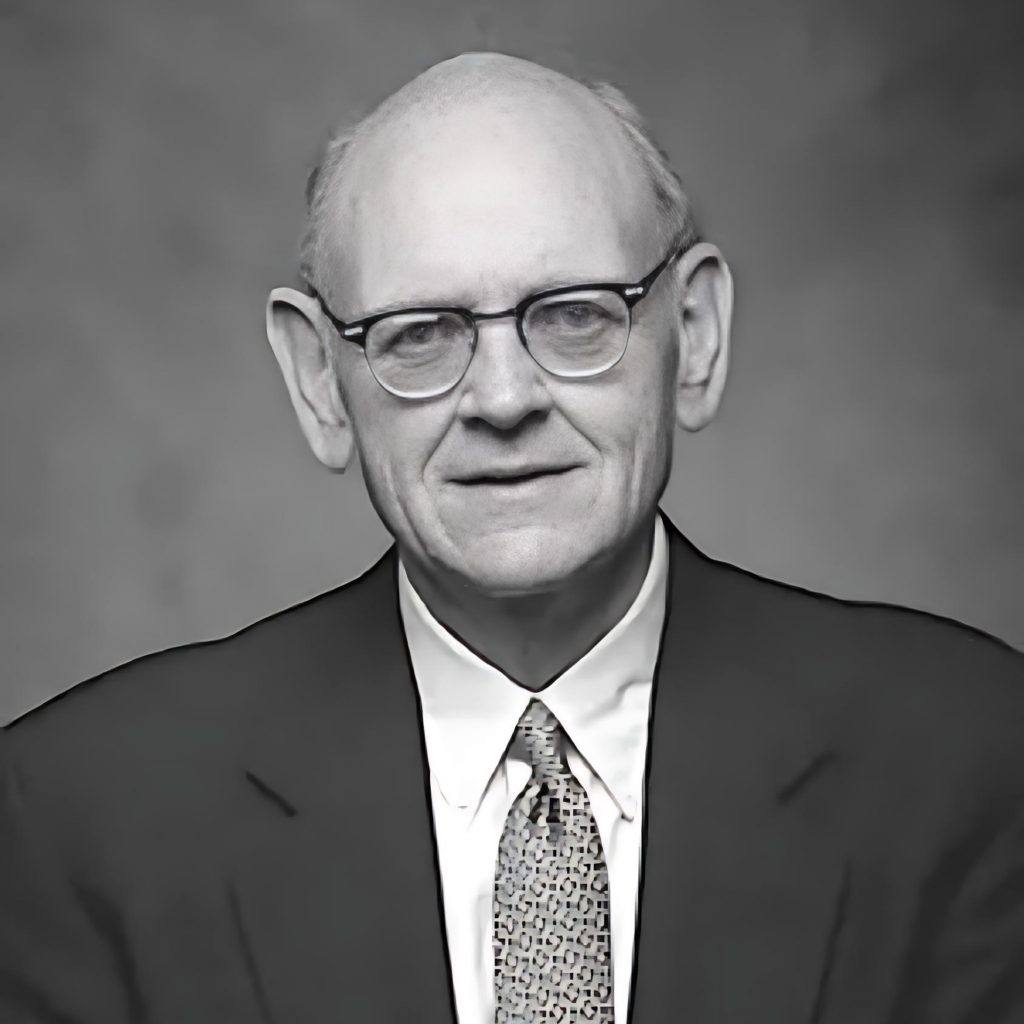
George Young
General Manager – 1979-1997
Hall of Fame Class of 2020
George Young was the quiet force who rebuilt the New York Giants from years of struggle into one of the NFL’s model franchises. When he became general manager in 1979, the team had not reached the postseason in 15 years. Through shrewd drafting, smart leadership, and a steady hand, Young transformed the Giants into consistent contenders and eventual champions.
He made the draft the cornerstone of success, selecting future Hall of Famers like Lawrence Taylor and Harry Carson, and later hiring Bill Parcells as head coach. Under his guidance, the Giants captured eight playoff berths and two Super Bowl titles, restoring pride to the organization.
Respected across the league for his integrity and football intellect, Young was a five-time NFL Executive of the Year — an unmatched achievement. His career, which began as a teacher and coach in Baltimore, reflected a lifelong devotion to education, discipline, and the game itself. George Young built winners not just on the field, but within the culture of the Giants.
Rep the Team, No Matter What!
Even through the ups and downs, we bleed blue. And if you’re gearing up for a fresh season, there’s no better way than with the just-released Jaxson Dart New York Giants jersey — flying off the shelves! It’s the hottest gear in the building right now, and the perfect way to show your faith in Big Blue’s future.
Ready for Redemption? Grab Tickets Now!
The past is behind us. A new season is coming, and hope is alive. Want to be there when the Giants start writing a new chapter? Head to StubHub to grab your tickets for the home opener at MetLife Stadium!
More Giants Talk Every Week.
We’ll be covering more Giants drama, victories, and throwbacks every week. Don’t miss a post—subscribe below and stay in the loop all season long.
